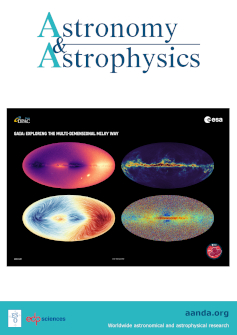了解致密气体中恒星形成的效率:利用 ArTéMiS★ 进行 CAFFEINE 勘测的初步结果
IF 5.4
2区 物理与天体物理
Q1 ASTRONOMY & ASTROPHYSICS
引用次数: 0
摘要
背景。尽管最近取得了一些进展,但星系中恒星形成效率(SFE)的调节因素仍然是天体物理学中争论最多的问题之一。主流观点认为,恒星形成(SF)受湍流和反馈的调节,从银河系云到高红移星系,在所有尺度上,每局部自由落体时间的恒星形成率(SFE)约为1-2%或更低。在另一种情况下,星系盘中的恒星形成率(SFR)与超过某个临界密度阈值~104 cm-3的致密气体质量成线性比例。我们利用高分辨率的亚毫米波和中红外成像观测,对银河系盘中距离 d ~ 3 kpc 的 49 个邻近大质量 SF 复合体样本进行了高密度气体和年轻恒星天体(YSO)的综合跟踪观测,旨在区分这两种情况。CAFFEINE是利用APEX/ArTéMiS对d ≲ 3 kpc处所有南方分子云最稠密的部分进行的一次完整的350/450 µm巡天,我们利用CAFFEINE的数据,结合Herschel的数据绘制了柱密度图,其分辨率(8")比标准的Herschel柱密度图(36″)高出约4倍。我们的地图在高亮度高质原恒星天体周围不存在任何饱和效应,并能解析稠密气体的结构和典型的 ~0.1 pc 宽度的分子细丝,最远可达 3 kpc,这是本研究最重要的资产,也是仅靠赫歇耳数据无法实现的。结合斯皮策(Spitzer)中红外观测对同一云中的 YSO 含量得出的 SFR 估计值,我们可以研究 CAFFEINE 云中的 SFE 与密度的关系。我们还将我们的发现与附近云层中现有的SF效率测量结果相结合,将我们的分析扩展到更低的柱密度。我们的结果表明,在临界阈值以上,SFE并不随密度的增加而增加,并支持稠密气体中的SFE近似恒定(与自由落体时间无关)的设想。然而,I类YSO在附近云层中追踪到的SF效率测量结果却并不确定,因为它们既符合密度临界值的存在,也符合临界值以上密度的依赖性。总之,我们认为稠密气体中的SF效率主要受长丝碎裂成原恒星核心的物理过程的制约。本文章由计算机程序翻译,如有差异,请以英文原文为准。
Understanding the star formation efficiency in dense gas: Initial results from the CAFFEINE survey with ArTéMiS★
Context. Despite recent progress, the question of what regulates the star formation efficiency (SFE) in galaxies remains one of the most debated problems in astrophysics. According to the dominant picture, star formation (SF) is regulated by turbulence and feedback, and the SFE is ~1–2% or less per local free-fall time on all scales from Galactic clouds to high-redshift galaxies. In an alternate scenario, the star formation rate (SFR) in galactic disks is linearly proportional to the mass of dense gas above some critical density threshold ~104 cm–3.Aims. We aim to discriminate between these two pictures thanks to high-resolution submillimeter and mid-infrared imaging observations, which trace both dense gas and young stellar objects (YSOs) for a comprehensive sample of 49 nearby massive SF complexes out to a distance of d ~ 3 kpc in the Galactic disk.Methods. We used data from CAFFEINE, a complete 350/450 µm survey with APEX/ArTéMiS of the densest portions of all southern molecular clouds at d ≲ 3 kpc, in combination with Herschel data to produce column density maps at a factor of ~4 higher resolution (8") than standard Herschel column density maps (36″). Our maps are free of any saturation effect around luminous high-mass pro-tostellar objects and resolve the structure of dense gas and the typical ~0.1 pc width of molecular filaments out to 3 kpc, which is the most important asset of the present study and is impossible to achieve with Herschel data alone. Coupled with SFR estimates derived from Spitzer mid-infrared observations of the YSO content of the same clouds, this allowed us to study the dependence of the SFE on density in the CAFFEINE clouds. We also combine our findings with existing SF efficiency measurements in nearby clouds to extend our analysis down to lower column densities.Results. Our results suggest that the SFE does not increase with density above the critical threshold and support a scenario in which the SFE in dense gas is approximately constant (independent of free-fall time). However, the SF efficiency measurements traced by Class I YSOs in nearby clouds are more inconclusive, since they are consistent with both the presence of a density threshold and a dependence on density above the threshold. Overall, we suggest that the SF efficiency in dense gas is primarily governed by the physics of filament fragmentation into protostellar cores.
求助全文
通过发布文献求助,成功后即可免费获取论文全文。
去求助
来源期刊

Astronomy & Astrophysics
地学天文-天文与天体物理
CiteScore
10.20
自引率
27.70%
发文量
2105
审稿时长
1-2 weeks
期刊介绍:
Astronomy & Astrophysics is an international Journal that publishes papers on all aspects of astronomy and astrophysics (theoretical, observational, and instrumental) independently of the techniques used to obtain the results.
 求助内容:
求助内容: 应助结果提醒方式:
应助结果提醒方式:


